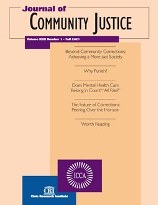Complete Issue
Author: Donald G. Evans.
Source: Volume 28, Number 02, Winter 2019 , pp.1-32(32)

< previous article |return to table of contents
Abstract:
The articles in this issue of JCC include a discussion about building a positive self-identity in persons convicted of sexual offenses, an overview of current research on day reporting centers, a perspective on securing employment and housing after prison, and three revised policy positions issued by the International Community Corrections Association on managing sexual offenders in the community, sitting community corrections facilities, and transition and reentry services for released offenders. Dr. Randy Shively, director of research and clinical development at Alvis, a community corrections agency in Columbus, Ohio, discusses the importance for correctional practitioners working with sexual offenders to separate themselves from the clients’ crimes and to help them see their offenses as bad rather viewing themselves as irredeemable. He explores the issue of toxic shame, which inhibits the development of a positive self-identity, and the alternative of redemptive guilt, which pursues the possibility of developing hope for the future. He bases his discussion on the strength-based approach of the Good Lives Model, which is future oriented and goal directed. During the last decade, the concept of the day reporting center (DRC) has re-emerged as a complement to community supervision and an aid to offenders released from either courts or prisons. In this overview of research on the functions and purposes of these centers, Dr. Ralph Fretz, director of research for the GEO Group, provides an overview of what is known about the effectiveness as well as the shortcomings of some of the DRC program models. Dr. Fretz provides a brief history of DRCs, discusses the research about them, and makes recommendations for enhancing their utility as alternatives to incarceration or reincarceration. He concludes with a discussion of the complications encountered in the research and makes recommendations for future research efforts. Famke Van Heugton, a social work student from Hogeschool Avans, in the Netherlands, writes of her experience serving as an international student placement at a day reporting center in Toronto, Canada. Her article is a combination of her personal perspective on what she witnessed while there and the information contained in a workshop presentation by the same name given at the ICCA Seattle Research Conference on October 31, 2017, by Donald Evans and Jaime Tilston, her placement supervisor. This original approach, geared toward encouraging the next generation of practitioners to reflect on what they are witnessing as they develop their skills and knowledge about work with those in conflict with the justice system, can prove beneficial both to the individual and the agency hosting the student. Personal perspectives of the students and staff in our agencies provide useful avenues to understand what affects our policies and program outcomes. Bearing witness to what is being tried and done in community corrections is essential to future developments and innovations. The International Community Corrections Association recently issued three policy positions relating to current issues in community corrections. The first relates to managing sexual offenders in the community; the second addresses the issue of sitting community corrections facilities; and the third deals with issues and needs in transition and reentry services. These policy positions were reviewed and adopted by the ICCA Board of Directors at their October 5, 2018, meeting. All of ICCA’s current policy positions can be viewed on its website.Keywords: Sex Offenses; Day Reporting Centers; Housing and Homelessness Post-Incarceration; ICCA Policy Positions
Affiliations:
1: Journal Editor.